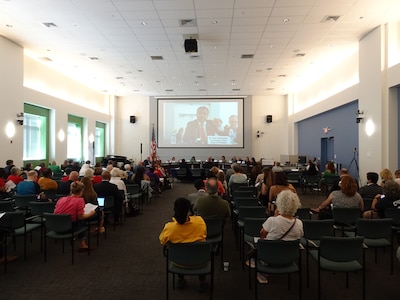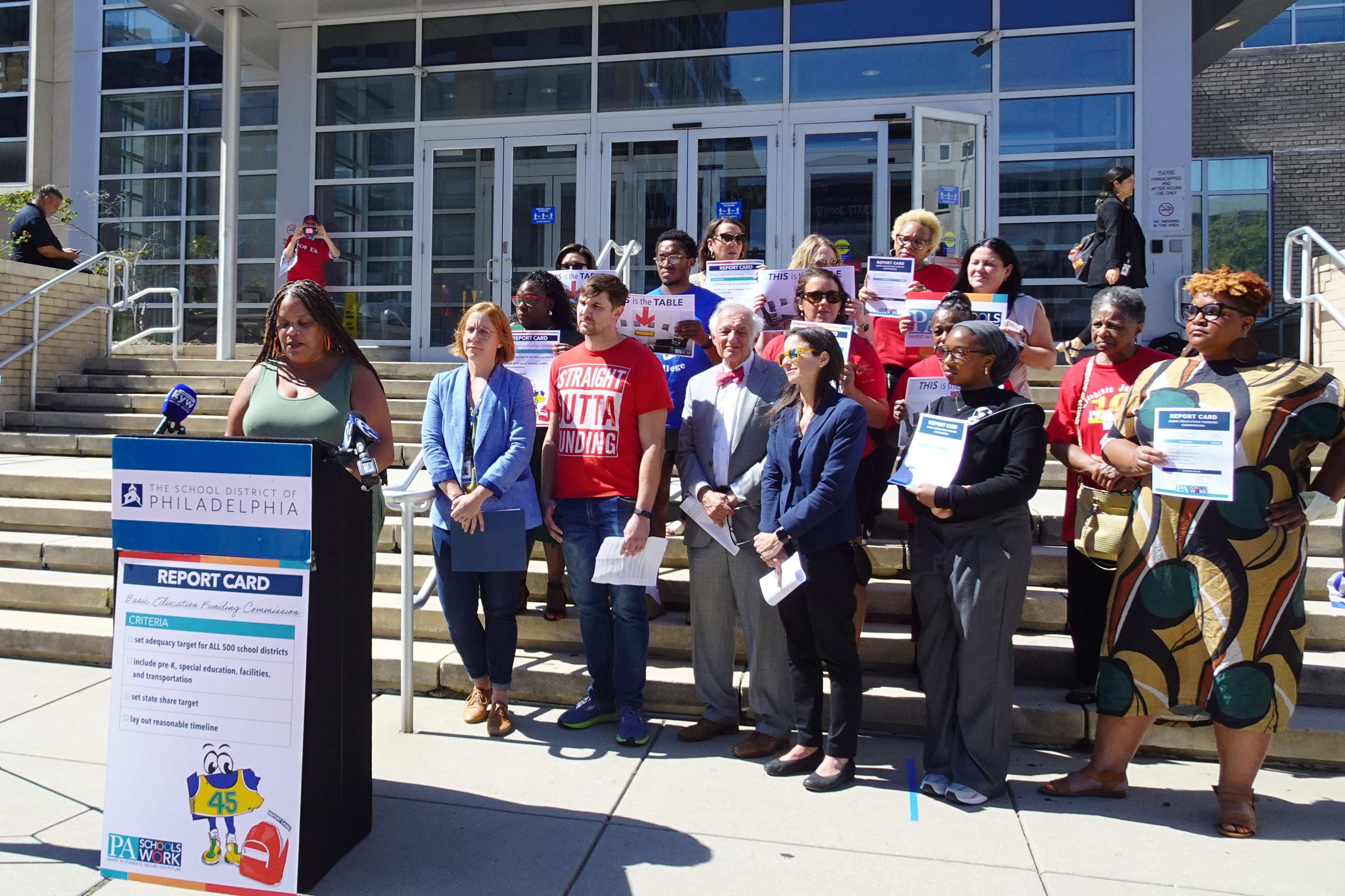Sign up for Chalkbeat Philadelphia’s free newsletter to keep up with the city’s public school system.
On the heat-soaked steps of the Philadelphia School District building Thursday, education advocates, teachers, and elected officials sought help for city students forced to learn in underfunded schools.
“Children are in crisis,” said Maritza Guridy, deputy director of parent power and outreach at the National Parents Union. They’re “struggling to survive.”
Behind those speaking, 12 legislators and staff entered the front doors preparing to sit for a three-hour hearing of the state’s Basic Education Funding Commission. The newly formed group is tasked with overhauling one of the most inequitable education funding systems in the nation after a court ruled the current system is unconstitutional.
The 15-member commission launched a series of hearings across the state this week to get feedback on how much to invest in education and how to distribute the aid.
“We need to listen to everyone and we may like what we hear, we may not like what we hear,” Sen. Kristin Philipps-Hill, a Republican from York, said in her opening remarks, adding that lawmakers must work in a bipartisan fashion to make sure student needs are met.
Pennsylvania is embarking on this long overdue — and constitutionally mandated — effort to overhaul the school funding formula because the current one is “shortchanging” students across the state, including those in Philadelphia, school board Vice President Mallory Fix-Lopez said to the group rallying outside the hearing.
Generations of underfunding means students in the city — who are predominantly Black, brown, and from low-income families — have had larger class sizes, less qualified and experienced teachers, older and often unsafe buildings, and fewer extracurricular opportunities compared to students in wealthier Pennsylvania districts.
Outside on Thursday, Philadelphians decried how long it’s taken to get here and the toll it’s exacted on students.
“Aren’t we tired of just talking about it?” Fix-Lopez asked. “I’m ready for change.”
The commission will deliver a report to Gov. Josh Shapiro by the end of November and produce a new formula in time for next spring’s budget negotiations. If lawmakers’ proposed formula doesn’t measure up, the state could find itself back in court, said Michael Churchill of the Public Interest Law Center, one of the groups representing the plaintiffs in the funding lawsuit.
Philadelphia Superintendent Tony Watlington, now in his second year in office, has crafted an ambitious five-year strategic plan for the district but has said he lacks the funding to carry it out.
“The Pennsylvania public school funding system has inadequately and inequitably funded low-wealth school districts for decades,” Watlington told the commission. “The funding system systematically harmed the very districts that need the most resources … those districts who serve students with the greatest needs.”
What the commission will do
Beyond trying to create a formula that is more fair, the commission must deal with the question of adequacy, or how much the state should be contributing to education so all students get a quality education. Pennsylvania now ranks 45th among states in the proportion of state versus local funding, providing only 38% of the total, compared to a national average of 47%.
A new formula and more money for Philadelphia schools will mean the difference between cutting programs and expanding access to things like high-dosage tutoring, algebra courses, and extracurriculars.
But it’s going to be costly. Penn State professor Matthew Kelly told the commission during an earlier hearing on Tuesday the state needs to spend an extra $6.2 billion each year to adequately fund education for all students. Philadelphia falls short by nearly $8,000 per student, Kelly found.
And that estimate doesn’t include facilities costs to manage environmental hazards like asbestos and broken or inadequate air conditioning. Watlington told the commission that the district was forced to close more than 80 buildings early each day during the first week of school because they lack no air conditioning. To fully modernize and repair the district’s infrastructure would cost $7.9 billion, he said, citing a 2017 study.

How Philly measures up
Philadelphia is not the lowest funded among Pennsylvania’s 500 districts. In fact, it is in the top half, ranking 232nd in per student revenue.
Other districts, large and small, have even larger “adequacy” gaps, including Allentown, Reading, Panther Valley, and Shenandoah. Kelly found that 412 of the state’s 500 districts fall short of what’s necessary to provide all students with a quality education.
“There is a cross section of districts that are dramatically underfunded,” Dan Urevick-Ackelsberg, senior attorney with the Public Interest Law Center, said in an interview.
And while, statewide, there are more white students in underfunded districts, “kids of color are dramatically concentrated in them,” he said.
At the hearing, Jerry Jordan, president of the Philadelphia Federation of Teachers, and Ashley Cocca, a counselor at Bache-Martin elementary school, talked about the trauma that many students face.
“Gun violence, drug presence, poverty levels, housing inadequacies, domestic violence, underemployment, tragic loss….inconsistent continuity of care,” Cocca said, choking up. Jordan said Philadelphia students need as much, if not more, than counterparts in wealthier areas.
A bipartisan solution will be needed
Many of the state’s poorest districts are rural, and largely white, and educate the constituents of many Republican lawmakers who have resisted the plea for billions more in state money for education. In some of these districts, tax rates are sky high, but they can’t raise enough funds because property values are low and taxable industries are scant.
Over the years, Republicans have protested that there is no correlation between money and achievement, and argued at their funding trial that the state’s obligation ended with assuring that the most basic needs were met – essentially, providing buildings, classrooms, and teachers.
Sen. David Argall, at the commission’s hearing on Tuesday, said the state legislature has voted for “significant spending increases” in the past, but said “we haven’t seen the results that many had hoped for.”
Kelly told Argall, “the research is clear and unambiguous” on this front: “Increased spending does increase outcomes” for students.
In resisting the lawsuit, Republicans also argued that legislators, not judges, are charged with determining fair and adequate funding levels for schools.
But, in a February ruling that followed four months of testimony, Commonwealth Court Judge Renée Cohn Jubelirer firmly rejected that reasoning, saying in a 786-page opinion that the current system so severely shortchanges many students that she was compelled to intervene.
Republican legislative leaders decided not to appeal her decision, instead initiating a process to overhaul the funding system.
How school funding currently works
The biggest component of state school aid comes through the basic education line item in the budget, which is now $7.8 billion. In an effort to direct a higher proportion to the neediest districts in lieu of a formula overhaul, the legislature set aside millions in so-called “level up” funding directed toward the 100 poorest districts; this year, the amount is $100 million. That funding is still held up in a lingering legislative standoff.
The current formula — most recently reworked in 2016 — weights such factors as the number of students in low-income households, poverty concentration, the prevalence of students with disabilities and English learners, and a district’s local wealth and taxing capacity.
But the formula has not significantly reduced disparities in spending among districts because legislators at the time also introduced a “hold harmless” clause that guarantees that no district gets less than it did before, even if its enrollment drops. Lawmakers decided to apply the new formula only to a new aid, not to all aid.
This meant most of the funding is distributed based on student demographics from many years ago
While Jubelirer ruled the current formula to be unconstitutional, she did not prescribe a solution.
This is where the new education funding commission comes in.
After the listening tour, the commission will present a series of recommendations to Shapiro, who will then work to reach a deal with lawmakers on a new formula, likely to be enacted through the state budget process.
But that will take months, and some say Philadelphia students can’t wait much longer.
“We must fix it immediately,” State Sen. Vincent Hughes, a Democrat representing Philadelphia, said. “We have waited too long, generations have suffered.”
Correction: This story has been corrected to reflect the status of the distribution of “level up” funding and Dan Urevick-Ackelsberg’s role with the Public Interest Law Center.
Dale Mezzacappa is a senior writer for Chalkbeat Philadelphia, where she covers K-12 schools and early childhood education in Philadelphia. Contact Dale at dmezzacappa@chalkbeat.org.
Carly Sitrin is the bureau chief for Chalkbeat Philadelphia. Contact Carly at csitrin@chalkbeat.org.






